Graham Reid | | 5 min read
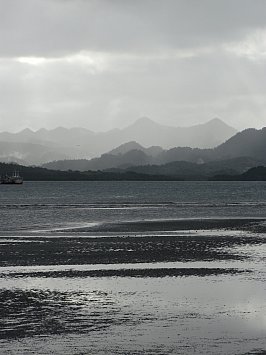
Give
them credit, they were persistent.
When the
Reverend Thomas Baker, a Methodist minister, unintentionally insulted
a chief on the Fijian island of Viti Levu in 1867, he and six of his
Fijian followers were hacked to death and eaten.
Baker
has the dubious honour of being the only European Methodist to be
dispatched in such a way.
And the
people didn't stop with him. The story goes they also tried to eat
his boots, bits of one being on display in the Fiji Museum just 10
minutes walk from downtown Suva.
Here is
a glass case you may also see Rev. Baker's Bible,
the bowl he was served up in and a large wooden fork.
Suva's
small but fascinating museum offers an insight into many and often
confusing aspects of Fiji's social, religious and political history,
among them that 19th
century missionaries spread the idea Fijians were descended from
Egyptians. This lead to a local paper in 1892 telling of the journey
from Thebes up the Nile to Lake Tanganyika and then on to Fiji in the
Kaunitoni canoe.
There
are many such marginalia in the museum but the visitor is greeted on
entry by the impressive out-rigger Ratu Finau -- “the last Waqa
Drua” (ocean-going canoe) – of 1913 which has a main hull 13.4m
long and massive steering oars which needed four men – four Fijian
men, remember – to operate.
This, we
are told, “is a relatively small canoe in comparison to those from
the 1800s”.
The
museum not only offers artefacts such as 3000 year old Lapita pottery
and distilled history (how the population fell from 250,000 to just
85,000 between 1800 and 1921 through the ravages of imported European
diseases), but oddities of specific interest to the New Zealand
visitor.
Here is
a 1991 wedding dress made of masi (tapa) by New Zealander designer
Annie Bonza, and Maori designs are incorporated into Fijian carving.
Then
there is the bamboo fishtrap which coincidentally looks like a
vuvuzela and is called a “vuvu”.
A day in
the Fiji Museum is one well spent, and just getting there is an
interesting walk from downtown cosmopolitan Suva and its multi-ethnic
shops, traffic (not as laid back as the stately walking pace of its
citizens) and jigsaw of architecture from handsome colonial to odd
Art Deco and 70s embarrassments.
The
museum is located in Thurston Garden with a large clocktower
dedicated to the first mayor of Suva G.J. Marks who was drowned in
the St Lawrence River, Canada in 1914 when the SS
Empress of Ireland sank.
The
garden, a steamy blend of unconstrained tropical growth and manicured
areas, is a perfect place to take some time out of sprawling Suva
which has a population in the greater area of around 500,000.
And it
is opposite the playing fields of Albert Park.
If World
Cup football matches are won in the academies of Europe, then the
Rugby Sevens' training ground is a place like Albert Park where
athletic schoolboys bail out of the back of a truck, sing a hymn then
play finger-tip, passing rugby at great speed, with slamming body
contact and no time wasted for injury stoppages. It is something to
see.

I asked
if I could look inside, was waved on with a smile, and the young
soldier accompanying me and I bemoaned its condition as we stood in
the grand hall looking at the blue ocean beyond.
The
presence of soldiers reminds you that despite the business-as-usual
all around you, politics is inescapable in any discussion of
present-day Fiji.
But here
the museum is also useful in that it offers the long view of Fiji's
troubled history since the early colonial period.
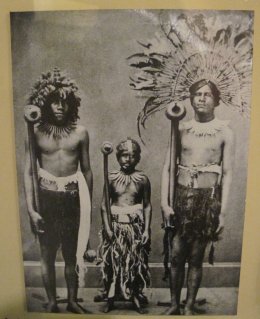 There
you may read of the Kingdom of Fiji and the short-lived Cakobau
Government (1871-74) which printed its own paper money in the years
before the country became a British colony; of the shameful
“blackbirding” (coercing or kidnapping of people from other
islands, notably the Solomons, to work on plantations); of the dwarf
priest (pictured left with two warriors and the pickled arm of a slain
chief) who was sold to Barnum, Coup and Costello's American circus to
raise funds for the government in the late 19th
century; of the indentured labourers from India (the practice only
officially ended 100 years ago) . . .
There
you may read of the Kingdom of Fiji and the short-lived Cakobau
Government (1871-74) which printed its own paper money in the years
before the country became a British colony; of the shameful
“blackbirding” (coercing or kidnapping of people from other
islands, notably the Solomons, to work on plantations); of the dwarf
priest (pictured left with two warriors and the pickled arm of a slain
chief) who was sold to Barnum, Coup and Costello's American circus to
raise funds for the government in the late 19th
century; of the indentured labourers from India (the practice only
officially ended 100 years ago) . . .
And of
Moy Bak Ling (pictured with his extended family) who went from Duan
Feng in China to the Australian goldfields as a 17-year old but fled
the appalling conditions three years later and sailed solo to Levuka
in 1855. His carpentry shop was the first Chinese business
established in Fiji.
Today, a
kilometre or so from the museum, the Chinese government is building
an enormous new embassy behind towering walls and using labourers
brought in from the mainland.
The
flags of China, Taiwan and Korea wave over aid projects, the
Americans have an equally large embassy and visible presence.
Politics
is everywhere and visitors will make what they will of it as daily
life goes on, although aspects of the unhappy past inevitably inform
the present.
 So the
museum is not the only place you can feel Fiji's complex story. You
can see it reflected in something as simple as shopfronts in Suva,
such as the old Regal on Victoria Parade which, in what must have
been a cinema with a suggestion of Art Deco in its graceful curves,
now houses a Pizza Express, a cake shop and the Capital Palace
Chinese restaurant.
So the
museum is not the only place you can feel Fiji's complex story. You
can see it reflected in something as simple as shopfronts in Suva,
such as the old Regal on Victoria Parade which, in what must have
been a cinema with a suggestion of Art Deco in its graceful curves,
now houses a Pizza Express, a cake shop and the Capital Palace
Chinese restaurant.
It is
right next to a McDonalds on the edge of Ratu Sukuna Park.
In that
one small corner of downtown Suva you can read the names and feel
something of the complex, interlocked past and present of this
interesting city.
For other travel stories by Graham Reid, see here for his two award-winning travel books.

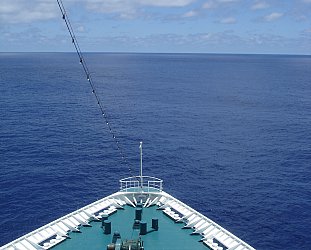
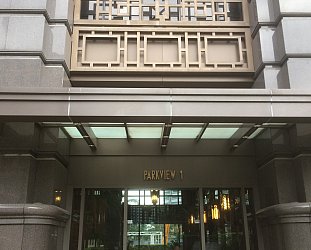

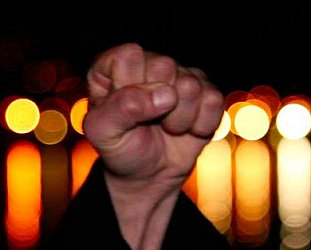

post a comment